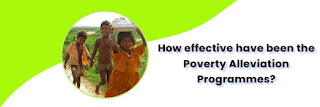Poverty Alleviation Programmes in India Class 12 Economics
Reduction of poverty The government starts programmes to help the underprivileged people in society. Such a programme produces a variety of available possibilities.
For quick reference, a number of significant poverty reduction initiatives are listed below in brief:
The streamlined, reorganised, and complete version of the Jawahar Rozgar Yojana is known as the Jawahar Gram Samridhi Yojana. This programme had been launched on April 1st, 1999. This program's goal was to protect rural areas.
National Pension System (NPS): Launched in 2004 for all government employees, the National Pension System (NPS) may be a government-sponsored pension plan. In 2009, the programme opened its doors to all citizens. It is a long-term, voluntary retirement plan.
National Family Benefit Scheme (NFBS): In August 1995, the NFBS programme was launched. The government supported this scheme. After 2002–2003, nevertheless, this programme has been moved to the state sector programme. It is a part of the rural and community departments.
Pradhan Mr. Gramin The Awas Yojana
Pradhan Mantri Gramin Awaas Yojana: The goal of this programme is to provide housing for all people. It was first started in 1985. 20 lakh housing units were to be built, of which 13 lakh will be in rural areas. This plan will also offer subsidised loans to people for the construction of homes. It had begun in 1999 or 2000.
Know more

Comments
Post a Comment
Thank you we will contact ASAP.